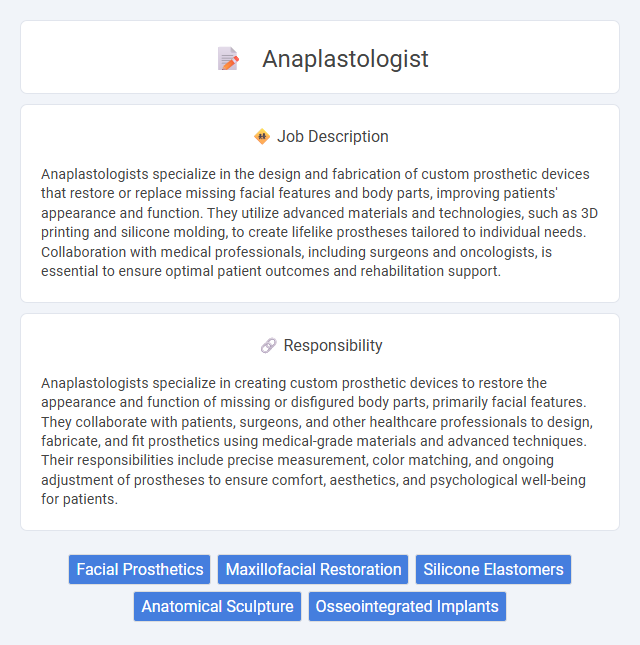
Anaplastologists specialize in the design and fabrication of custom prosthetic devices that restore or replace missing facial features and body parts, improving patients' appearance and function. They utilize advanced materials and technologies, such as 3D printing and silicone molding, to create lifelike prostheses tailored to individual needs. Collaboration with medical professionals, including surgeons and oncologists, is essential to ensure optimal patient outcomes and rehabilitation support.
Individuals with a strong interest in medical art and rehabilitation are likely suitable for a career as an anaplastologist, as the role involves creating prosthetic devices to restore patients' appearances and confidence. Those who are detail-oriented, empathetic, and possess fine manual dexterity may find the job fulfilling, given the precise craftsmanship and patient interaction required. Candidates unwilling to engage with emotionally sensitive situations or lacking patience might find this profession challenging.
Qualification
Anaplastologists typically require a master's degree in anaplastology, prosthetics, or a related healthcare field, combined with specialized training in facial and body prosthetic fabrication. Certification from the Board for Certification in Clinical Anaplastology (BCCA) enhances professional credibility and demonstrates expertise in creating custom prosthetic devices. Strong skills in anatomy, artistry, and materials science are essential to effectively restore patients' physical appearance and improve their quality of life.
Responsibility
Anaplastologists specialize in creating custom prosthetic devices to restore the appearance and function of missing or disfigured body parts, primarily facial features. They collaborate with patients, surgeons, and other healthcare professionals to design, fabricate, and fit prosthetics using medical-grade materials and advanced techniques. Their responsibilities include precise measurement, color matching, and ongoing adjustment of prostheses to ensure comfort, aesthetics, and psychological well-being for patients.
Benefit
Anaplastologists likely provide significant benefits by restoring facial and body features for patients affected by trauma, surgery, or congenital disabilities. Their expertise probably improves individuals' self-esteem and social interactions by creating lifelike prosthetics that blend seamlessly with natural skin tones and textures. This field may offer rewarding opportunities to enhance quality of life through personalized, artistic, and medically informed solutions.
Challenge
Anaplastologists likely face the challenge of creating highly realistic prosthetic devices that restore both function and appearance, requiring precision and artistic skill. The difficulty in matching skin tone, texture, and facial expressions may pose ongoing complexity in their work. They probably encounter emotional challenges as they support patients adapting to life-changing prosthetics.
Career Advancement
Anaplastologists specialize in creating custom prosthetic devices to restore the appearance and function of missing or disfigured body parts, often collaborating with surgeons and patients for optimal outcomes. Career advancement typically involves gaining expertise in advanced materials, digital imaging, and 3D printing technologies, which are increasingly crucial in the field. Progression can lead to roles such as senior anaplastologist, research specialist, or educator, with opportunities to influence prosthetic innovation and patient care standards.
Key Terms
Facial Prosthetics
Anaplastologists specializing in facial prosthetics design and fabricate custom-made prosthetic devices that restore the appearance and function of facial features lost due to trauma, disease, or congenital conditions. These experts utilize advanced materials, 3D modeling, and pigmentation techniques to create lifelike prostheses that improve patients' quality of life and psychological well-being. Collaboration with surgeons, oncologists, and patients ensures optimal fit, comfort, and aesthetic integration of facial prosthetics.
Maxillofacial Restoration
An anaplastologist specializing in maxillofacial restoration creates custom prosthetic devices to rehabilitate patients with facial defects caused by trauma, cancer, or congenital disorders. These specialists utilize advanced materials and digital imaging technology to fabricate realistic facial prostheses that restore both function and appearance. Expertise in anatomy, sculpture, and color matching ensures the prostheses provide psychological and social benefits by improving patient confidence and quality of life.
Silicone Elastomers
Anaplastologists specialize in creating custom silicone elastomer prosthetics that restore anatomical features with lifelike texture and flexibility. Expertise in silicone elastomers enables precise color matching, durability, and comfort crucial for facial and body prostheses. Mastery of mold-making and silicone casting techniques is essential to fabricate realistic, functional anaplastology devices tailored to patient needs.
Anatomical Sculpture
Anaplastologists specialize in creating highly detailed anatomical sculptures that restore or simulate missing or disfigured parts of the human body, such as ears, noses, and eyes. They utilize advanced materials like silicone and medical-grade polymers to achieve lifelike textures and colors that match the patient's natural anatomy. Precision in anatomical accuracy and artistic skill are crucial for enhancing patients' appearance and psychological well-being through custom prosthetic devices.
Osseointegrated Implants
Anaplastologists specializing in osseointegrated implants create customized prosthetic devices that securely attach to bone, enhancing facial restoration for patients with craniofacial defects. Utilizing advanced osseointegration techniques, these specialists improve prosthesis stability and patient comfort, leading to better functional and aesthetic outcomes. Expertise in biocompatible implant materials and precise surgical collaboration ensures successful integration and long-term durability of facial prosthetics.
 kuljobs.com
kuljobs.com